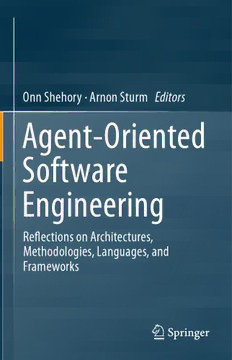Table Of ContentOnn Shehory · Arnon Sturm Editors
Agent-Oriented
Software
Engineering
Refl ections on Architectures,
Methodologies, Languages, and
Frameworks
Agent-Oriented Software Engineering
Onn Shehory • Arnon Sturm
Editors
Agent-Oriented
Software
Engineering
Reflections on Architectures,
Methodologies, Languages, and
Frameworks
123
Editors
OnnShehory ArnonSturm
IBMHaifaResearchLaboratory Ben-GurionUniversityoftheNegev
Haifa Beer-Sheva
Israel Israel
ISBN978-3-642-54431-6 ISBN978-3-642-54432-3(eBook)
DOI10.1007/978-3-642-54432-3
SpringerBerlinHeidelbergNewYorkDordrechtLondon
LibraryofCongressControlNumber:2014940795
©Springer-VerlagBerlinHeidelberg2014
Thisworkissubjecttocopyright.AllrightsarereservedbythePublisher,whetherthewholeorpartof
thematerialisconcerned,specificallytherightsoftranslation,reprinting,reuseofillustrations,recitation,
broadcasting,reproductiononmicrofilmsorinanyotherphysicalway,andtransmissionorinformation
storageandretrieval,electronicadaptation,computersoftware,orbysimilarordissimilarmethodology
nowknownorhereafterdeveloped.Exemptedfromthislegalreservationarebriefexcerptsinconnection
with reviews or scholarly analysis or material supplied specifically for the purpose of being entered
and executed on a computer system, for exclusive use by the purchaser of the work. Duplication of
this publication or parts thereof is permitted only under the provisions of the Copyright Law of the
Publisher’slocation,initscurrentversion,andpermissionforusemustalwaysbeobtainedfromSpringer.
PermissionsforusemaybeobtainedthroughRightsLinkattheCopyrightClearanceCenter.Violations
areliabletoprosecutionundertherespectiveCopyrightLaw.
Theuseofgeneraldescriptivenames,registerednames,trademarks,servicemarks,etc.inthispublication
doesnotimply,evenintheabsenceofaspecificstatement,thatsuchnamesareexemptfromtherelevant
protectivelawsandregulationsandthereforefreeforgeneraluse.
While the advice and information in this book are believed to be true and accurate at the date of
publication,neithertheauthorsnortheeditorsnorthepublishercanacceptanylegalresponsibilityfor
anyerrorsoromissionsthatmaybemade.Thepublishermakesnowarranty,expressorimplied,with
respecttothematerialcontainedherein.
Printedonacid-freepaper
SpringerispartofSpringerScience+BusinessMedia(www.springer.com)
Foreword
In the late 1960s, computing practitioners began to realize that the rapid devel-
opments in computer hardware—making computers cheaper, faster, smaller, and
morereliable—werenotbeingmatchedby comparabledevelopmentsin software.
Onthecontrary,itwasrealizedthatdevelopingcorrect,efficient,reliablesoftware
was much harder than had been generally anticipated. The situation was brought
intocrispfocusbyastreamofhigh-profile(andhighlyexpensive)softwareproject
failures. The term “software crisis” was coined to describe this dismal state of
affairs, and thus was born the discipline of software engineering. Describing the
software development process as “engineering” made plain the aspirations of
the new discipline. The idea was that, ultimately, software development should
be an engineering discipline as robust and well understood as other engineering
disciplines.Thus,buildingalargesoftwaresystemshouldbenomorechallenging
than a civil engineering project such as building a bridge: complex, certainly, but
manageableandpredictablenonetheless.Ofcourse,thingshaven’tquiteturnedout
thatway,or atleastnotyet.In the45yearssincethe softwarecrisis, we have,for
sure,learnedahugeamountaboutthenatureofsoftwareandsoftwaredevelopment,
andtheeverydaysoftwareapplicationswetakeforgrantedwouldsurelyberegarded
as miraculous by the early software engineering pioneers. But this undoubted
successmasksadisappointingtruth:softwareremainshardtodevelop,andsoftware
projectfailuresarefarfromuncommon.Poorlydesigned,poorlyimplemented,and
error-pronesoftwareisalltoocommon.Thedisciplineofsoftwareengineeringthus
remainsasrelevantandcentraltocomputerscienceasitwasin1970.
Contemporary software engineering encompasses a wide range of computa-
tionalparadigms:proceduralprogramming,object-orientedprogramming,service-
oriented programming, aspect-oriented programming, functional programming,
logicprogramming,andsoon.Eachdifferentparadigmencouragesustothinkabout
computationina differentway,andeachcomeswithits owncollectionofmodels
and development techniques and its own design aesthetic. Logic programming,
for example, promotes the idea of computation as automated deduction, while
service-orientedcomputingadopts the idea of programsas service providers.The
multi-agent systems research domain, which emerged largely as a subfield of
v
vi Foreword
artificialintelligenceinthe1990s,isconcernedwithbuildingcomputersystemsthat
caneffectivelycooperatewitheachother,andinthe1990s,anumberofresearchers,
myselfincluded,begantothinkaboutagentsasasoftwareengineeringparadigm.If
thebannercarriedbythelogicprogrammingcommunitycarriestheslogan“compu-
tationasdeduction,”thenthebannercarriedbythemulti-agentsystemscommunity
mightread“computationascooperation,”orperhaps“computationasinteraction.”
Adopting an agent-orientedview of software engineeringimplies conceptualizing
computer systems as consisting of collections of interacting (semi)autonomous
agents:theagentsareseenasactingindependentlyinpursuitofgoalsdelegatedto
thembyusers.Theargumentsinsupportofanagent-orientedsoftwareengineering
viewpointarewellknown,andIwon’trehashthemhere:forme,thekeypointisthat
themostnaturalwayofconceptualizingcertainsystemsisassocietiesofinteracting,
semiautonomousagents.Indeed,inasystemwherecontrolisinherentlydistributed
overmultiplestakeholderswithpotentiallycompetinginterests,itishardtoimagine
anyotherreasonableconceptualization.Ifyouacceptthis,thenwhatfollowsisthe
paradigmofagent-orientedsoftwareengineering.
If we hope to put agent-oriented software engineering on a par with other
software engineering paradigms, then there are a whole raft of issues we need to
address. First, and most fundamentally, we need to develop the right conceptual
toolkit:What are the key conceptsin agent-orientedsoftware engineeringthat we
use in the analysis and design of systems? These concepts will then underpin
methodologies for the analysis and design of multi-agent systems, programming
languagesand developmentplatformsfor building and deployingsystems, and so
on. There have been substantial developments in all of these areas since agent-
orientedsoftwareengineeringwasfirstmootedinthe1990s.
Thepresentvolumeisastate-of-the-artcollectionofchaptersonagent-oriented
software engineering. The chapters presented herein address all the issues that I
mentionedabove,frommethodologiestoprogramminglanguagesanddevelopment
platforms.While thisvolumedoesnotmarktheendofthestoryofagent-oriented
software development, it does, I think, represent an important milestone in the
historyofthefieldandwillsurelypromptmuchfutureresearchanddevelopment.
Oxford,UK MichaelWooldridge
Spring2014
Preface
Agent-based systems have evolved significantly during the last two decades.
The development of such systems involves, among others, artificial intelligence,
distributed systems, and software engineering.In this book, we focus on the soft-
ware engineering facet of agent-based systems, namely, Agent-Oriented Software
Engineering(AOSE).Inparticular,thebookconsistsofacollectionofstate-of-the-
art studies in the AOSE domain. The chapters are organized in five parts: Part I
introducestheAOSEdomain;PartIIreferstothegeneralaspectsofAOSE;PartIII
deals with AOSE methodologies; Part IV addresses agent-oriented programming
languages; and finally Part V presents studies related to the implementation of
agentsandmulti-agentsystems.
Part I Introduction
ThispartincludesChaps.1,2,and3andintroducesAOSEasdetailedbelow.
Chapter 1 introduces the notion of software agents with an emphasis on core
design and engineering aspects. It elaborates on agent propertiesand dimensions,
emphasizingthenovelconceptsandabstractionsintroducedbyagent-basedsystems
tosoftwaresystems’designandimplementation.
In Chap. 2, we attempt at defining what AOSE is, make the case for its
emergence,andreviewitsevolutionthroughouttheyears.Wealsoprovideinsights
intothecurrentstatusoftheAOSEdomainandpointoutfutureresearchdirections.
Chapter 3, written by Jörg Müller and Klaus Fischer, examines the practical
applicationof multi-agentsystemsandtechnologies.The examinationis based on
acomprehensivesurveyofMASdeploymentsandchecksthematurity,ownership,
applicationdomains,programminglanguages,andplatformsofthesedeployments.
The chapter concludesthat MAS applicationshave been successfully deployedin
asignificantnumberofapplicationsandwerefoundtobeusefulinvariousmarket
sectors.
vii
viii Preface
Part II Aspects ofAgent-Oriented Software Engineering
ThispartincludesChaps.4,5,and6anddiscussesthegeneralaspectsofAOSE.
In Chap. 4, we discuss the notion of multi-agent architectures and address the
meritsofagentsandmulti-agentsystemsasasoftwarearchitecturestyle.
Chapter5,writtenbyJoannaJuziuk,DannyWeyns,andTomHolvoet,provides
areviewoftheusageofdesignpatternsthatarerelatedtoMAS.Overall,theauthors
foundthatalthoughmanypatternsexist,thesearenotwelldocumented,organized,
andlinked.Thus,theauthorsprovideguidelinesfortherequiredeffortsinorderto
increasetheusageofsuchpatterns.
Chapter 6, written by Marc-Philippe Huget, overviews the landscape of MAS
communication as a major means for applying MAS. In particular, the chapter
discusses agent communicationlanguages, ontologies, protocols, dialogue games,
argumentationsystems,andmultipartycommunication.
Part III Agent-Oriented Software Engineering
Methodologies
ThispartincludesChaps.7,8,9,and10andintroducesAOSEmethodologies.
In Chap. 7, we discussagent-orientedmethodologies,their desiredcharacteris-
tics, and the extentto which they addressthese properties.In addition, we review
researcheffortsrelatedtoAOSEmethodologies.
InChap.8,writtenbyLinPadgham,JohnThangarajah,andMichaelWinikoff,
the authorsdiscuss Prometheus,a well-established and widely used methodology.
Inparticular,theystresstheimportanceoftestingwithinthedevelopmentofMAS
andthechallengesthatexistinthisrespect.
InChap.9,writtenbyScottDeLoach,theneedforpractical,industrialstrengthof
agent-orientedmethodologiesisemphasized.Inthisrespect,thechapterintroduces
acustomizablemethodologythatcanbeadaptedandextendedforawidevarietyof
uses.
In Chap. 10, by Jorge Gomez-Sanz, the evolution of INGENIAS (a MAS
methodology) is described. In particular, the chapter emphasizes the engineering
aspectofdesigningthemethodologyanditssupportingtools.
Part IV Agent-Oriented Programming Languages
ThispartincludesChaps.11,12,and13andpresentsagent-orientedprogramming
languages.
In Chap. 11, by Mehdi Dastani, a survey of the multi-agent programming
researchfieldispresented.Inparticular,itdefinestheconceptsandabstractionsused
Preface ix
inmulti-agentsystemsandthewaytheseareintegratedintotheagentprogramming
languagesandframeworks.
Chapter12,byKoenHindriksandJürgenDix,introducesaBDI-basedMASpro-
gramminglanguagethatincorporatesSEprinciples.Thechapteralsodemonstrates
theuseofthelanguageanditssuccesswithinanexplorationgame.
Chapter 13, by Olivier Boissier, Rafael Bordini, Jomi Hübner, and Alessandro
Ricci, introduces JaCaMo, a platform for multi-agent-oriented programming that
incorporatesabstractionsrelatedtoagents,organizations,andenvironments,which
areessentialpartsofMASs.
Part V Multi-agentSystems Implementation
ThispartincludesChaps.14,15,and16andfocusesonmulti-agentimplementation.
In Chap. 14, we survey MAS platforms and frameworks that facilitate MAS
implementation. We introduce the reader to a variety of tools and analyze their
suitabilityforMASimplementationneeds.Theanalysisrevealsthatalthoughmany
toolsweredevelopedovertheyears,onlyafewofthosearecontinuallybeingused;
ithasalsobecomeapparentthattheevaluationsofthesetoolsareratherlimited.
Chapter15,byRenatoLevyandGoutamSatapathy,discussesdesignconsider-
ations of very large agent-based systems as applied to an energy distribution use
case. They further explore the nuances of the implementation of this use case in
CybelePro—an agent infrastructure—and stress the importance of verifying the
propertiesofsuchsystems.
Chapter16,byBennyLutati,InnaGontmakher,MichaelLando,ArnonNetzer,
Amnon Meisels, and Alon Grubshtein, introducesa frameworkfor agent-oriented
programming for distributed constraint reasoning. The framework facilitates the
programming of such agents, the simulation of such systems, and the evaluation
ofthesystem’sperformance.
Inthisbook,weaimtoexposethereadertovariousfacetsofAOSE.Wetherefore
provide a collection of state-of-the-art studies in this field. We believe that the
studies in this book are of interest to researchers, practitioners, and students who
areinterestedinexploringtheagentparadigmfordevelopingsoftwaresystems.We
notethatalthoughmanyresearcheffortshavebeenmadeinthisarea,therearemany
openissuesandchallengesthatneedtobeaddressedandexplored.
Beer-Sheva,Israel ArnonSturm
Haifa,Israel OnnShehory

